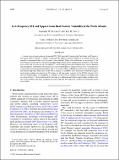Low-Frequency SST and Upper-Ocean Heat Content Variability in the North Atlantic
Author(s)
Buckley, Martha Weaver; Ponte, Rui M.; Forget, Gael; Heimbach, Patrick
DownloadBuckley-2014-Low-Frequency SST an.pdf (4.536Mb)
PUBLISHER_POLICY
Publisher Policy
Article is made available in accordance with the publisher's policy and may be subject to US copyright law. Please refer to the publisher's site for terms of use.
Terms of use
Metadata
Show full item recordAbstract
A recent state estimate covering the period 1992–2010 from the Estimating the Circulation and Climate of the Ocean (ECCO) project is utilized to quantify the upper-ocean heat budget in the North Atlantic on monthly to interannual time scales (seasonal cycle removed). Three novel techniques are introduced: 1) the heat budget is integrated over the maximum climatological mixed layer depth (integral denoted as H), which gives results that are relevant for explaining SST while avoiding strong contributions from vertical diffusion and entrainment; 2) advective convergences are separated into Ekman and geostrophic parts, a technique that is successful away from ocean boundaries; and 3) air–sea heat fluxes and Ekman advection are combined into one local forcing term. The central results of our analysis are as follows: 1) In the interior of subtropical gyre, local forcing explains the majority of H variance on all time scales resolved by the ECCO estimate. 2) In the Gulf Stream region, low-frequency H anomalies are forced by geostrophic convergences and damped by air–sea heat fluxes. 3) In the interior of the subpolar gyre, diffusion and bolus transports play a leading order role in H variability, and these transports are correlated with low-frequency variability in wintertime mixed layer depths.
Date issued
2014-07Department
Massachusetts Institute of Technology. Department of Earth, Atmospheric, and Planetary SciencesJournal
Journal of Climate
Publisher
American Meteorological Society
Citation
Buckley, Martha W., Rui M. Ponte, Gaël Forget, and Patrick Heimbach. “Low-Frequency SST and Upper-Ocean Heat Content Variability in the North Atlantic.” J. Climate 27, no. 13 (July 2014): 4996–5018.
Version: Final published version
ISSN
0894-8755
1520-0442